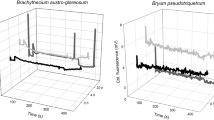Abstract
Most desiccation-tolerant plants alter shoot structure during drying, making it possible to use changes in surface reflectance as a proxy measure of plant water status. Diurnal courses of surface reflectance (albedo) and chlorophyll fluorescence parameters of the ectohydric moss, Tortula ruralis (Hedw.) Gaertn, were measured to assess the coordination between anatomical and physiological features under field conditions. Albedo showed a sigmoidal relationship with relative humidity and the deviation of moss mat temperature from dew point. Maximum photosynthetic quantum yield (F v/F m) also displayed a sigmoidal relationship pooled across three days differing in light, temperature, and relative humidity. Depending on the light conditions and rapidity of drying during the morning, there were distinct differences in the ability of T. ruralis to establish thermal dissipation of excess light energy (NPQ) across a range of light levels following rehydration through the day. These findings suggest that there is a coordinated suite of architectural and physiological characteristics maintaining the photosynthetic integrity of these plants in highly variable arid and semi-arid environments.
Similar content being viewed by others
References
Alpert, P. & Oechel, W. C. 1985. Carbon balance limits the microdistribution of Grimmia laevigata, a desiccation-tolerant plant. Ecology 66: 660–669.
Anderson, J. M., Park, Y. I., & Chow, W. S. 1997. Photoinactivation and photoprotection of photosystem II in nature. Physiol. Plant. 100: 214–233.
Casper, C., Eickmeier, W. G. & Osmond, C. B. 1993. Changes of chlorophyll fluorescence and xanthophyll pigments during dehydration in the resurrection plant Selaginella lepidophylla in low and medium light intensities. Oecologia 94: 528–533.
Csintalan, Zs., Takács, A., Proctor, M. C. F., Lichtenthaler, H. K. & Tuba, Z. 1998. Desiccation and rehydration responses of desiccation-tolerant moss and lichen species from a temperate semidesert grassland. J. Hattori Bot. Lab. 84: 71–80.
Csintalan, Zs., Proctor, M. C. F. & Tuba, Z. 1999. Chlorophyll fluorescence during drying and rehydration in the mosses Rhytidiadelphus loreus (Hedw.)Warnst., Anomodon viticulosus (Hedw.) Hook. & Tayl. and Grimmia pulvinata (Hedw.) Sm. Ann. Bot. 84: 235–244.
Deltoro, V. I., Calatayud, A., Gimeno, C. & Barreno, E. 1998. Water relations, chlorophyll fluorescence, and membrane permeability during desiccation in bryophytes from xeric, mesic and hydric environments. Can. J. Bot. 76: 1923–1929.
Deltoro, V. I., Calatayud, A., Gimeno, C., Abadia, A. & Barreno, E. 1998. Changes in chlorophyll a fluorescence, photosynthetic CO2 assimilation and xanthophyll cycle interconversions during dehydration in desiccation-tolerant and intolerant liverworts. Planta 207: 224–228.
Demming-Adams, B. & Adams III, W. W. 1992. Photoprotection and other responses of plants to high light stress. Annual Rev. Plant Physiol. Plant Molec. Biol. 43: 599–626.
Eickmeier, W. G., Casper, C. & Osmond, C. B. 1993. Chlorophyll fluorescence in the resurrection plant Selaginella lepidophylla (Hook & Grev.) Spring during high-light and desiccation stress, and evidence for zeaxanthin-associated photoprotection. Planta 189: 30–38.
Lange, O. L. & Tenhunen, J. D. 1981. Moisture content and CO2 exchange of lichens. II. Depression of net photosynthesis in Ramalina maciformis at high water content is caused by increased thallus carbon dioxide diffusion resistance. Oecologia 51: 426–429.
Lubkuecher, J. G. & Eickmeier, W. G. 1993. Physiological benefits of stem curling for resurrection plants in the field. Ecology 74: 1073–1080.
Oliver, M. J., Mishler, B. D. & Quisenberry, J. E. 1993. Comparative measures of desiccation-tolerance in the Tortula ruralis complex I: Variation in damage control and repair. Am. J. Bot. 80: 127–136.
Oliver, M. J. & Wood, A. J. 1997. Desiccation tolerance in mosses. Pp. 1–26. In: Koval, T. M. (ed), Stress-inducible processes in higher plants. Plenum Press, New York, U.S.A.
Osmond, C. B. 1994. What is photoinhibition? Some insights from comparison of shade and sun plants. pp 1–24. In: Baker, N. R. & Boyer, J. R. (eds), Photoinhibition: molecular mechanisms to the field. Bios Scientific Publications, Oxford, UK.
Osmond, C. B. & Grace, J. 1994. Perspectives on photoinhibition and photorespiration in the field: quintessential inefficiencies of the light and dark reactions of photosynthesis? J. Exp. Bot. 46: 1351–1362.
Proctor, M. C. F. 1979. Structure and eco-physiological adaptation in bryophytes. Pp. 479–509. In: Clarke, G. C. S. & Duckett, J. G. (eds), Bryophyte systematics. Academic Press, London, UK.
Proctor, M. C. F. 1984. Structure and ecological adaptation. Pp. 9–37. In: Dyer, A. F. & Duckett, J. G. (eds), The experimental biology of bryophytes. Academic Press, London, UK.
Sass, L., Csintalan, Zs., Tuba, Z., Vass, I. 1995. Changes in photosystem II activity during desiccation and rehydration of the desiccation tolerant lichen Cladonia convulata studied by chlorophyll fluorescence. Pp. 553–556. In: Mathis, P. (ed), Photosynthesis: from light to biosphere, Vol IV. Kluwer Academic Publishers, Dordrecht, The Netherlands.
Schreiber, U., Bilger, W., Hormann, H., & Neubauer, C. 1998. Chlorophyll fluorescence as a diagnostic tool: basics and some aspects of practical relevance. Pp. 320–336. In: Raghavendra, A. S. (ed), Photosynthesis, a comprehensive treatise. Cambridge University Press, Cambridge, UK.
Tuba, Z., Csintalan, Zs. & Proctor, M. C. F. 1996. Photosynthetic responses of a moss (Tortula ruralis spp ruralis), and the lichens Cladonia convoluta and C. furcata to water deficit and short periods of desiccation, and their ecophysiological significance: a baseline study at present-day CO2 concentration. New Phytol. 133: 353–361.
Tuba, Z., Proctor, M. C. F. & Csintalan, Zs. 1998. Ecophysiological responses of homoiochlorophyllous and poikilochlorophyllous desiccation tolerant plants: a comparison and an ecological perspective. Plant Growth Reg. 24: 211–217.
Valanne, N. (1984) Photosynthesis and photosynthetic products of mosses. Pp. 257–273. In: Dyer, A. F. & Duckett, J. G. (eds), The experimental biology of bryophytes. Academic Press, London, UK.
Zar, J. H. (1974) Biostatistical analysis. Prentice Hall, Engelwood Cliffs, N.J., USA.
Author information
Authors and Affiliations
Rights and permissions
About this article
Cite this article
Hamerlynck, E., Tuba, Z., Csintalan, Z. et al. Diurnal variation in photochemical dynamics and surface reflectance of the desiccation-tolerant moss, Tortula ruralis. Plant Ecology 151, 55–63 (2000). https://doi.org/10.1023/A:1026594623578
Issue Date:
DOI: https://doi.org/10.1023/A:1026594623578



